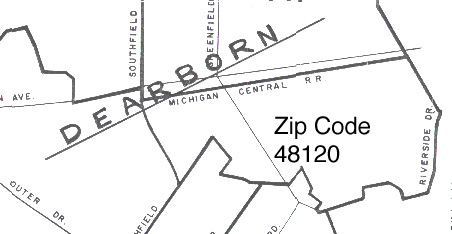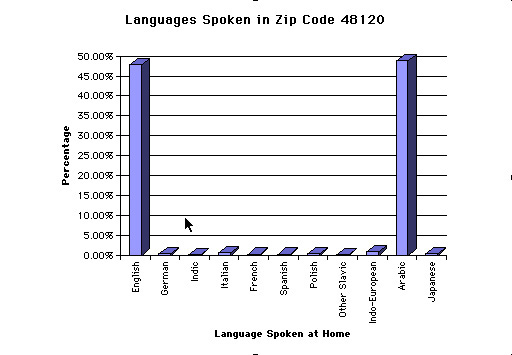 Rouge Steel
Rouge Steel
This industrial pollution in the community is consistent with the concept of environmental racism. Arab Americans living in the south end of Dearborn are disproportionately impacted by environmental hazards. As shown in chart 2 below, some of these chemicals pose serious health risks, including cancer, genetic or chromosomal mutation, reproductive defects, and damage to the nervous systems.
According to the study done by Phylecia Dorroh, of the ACCESS (Arab Community for Economic and Social Services) Environmental Program, there are at least ten carcinogens released into the evironment in Dearborn by local industry. Continued exposure to these carcinogens may cause an increase in illnesses such as leukemia and a variety of cancers. Genetic or chromosomal mutations occur due to the breakdown or mutation of DNA in a sperm or an egg. While no reported substances are yet classified by the EPA as potential genetic mutagens, some are found to cause mutations in animals.
Reproductive defects are caused by several different substances, such as cadmium, lead, manganese, and zinc. All four chemicals contributed to over 67 million pounds of toxic waste produced in Dearborn in 1992 alone. Also, over 10, 000 pounds of lead were released as air emissions by industrial facilities in Dearborn. Chronic exposure may cause a breakdown of the nervous system, Alzheimer's disease, and loss of memory and muscle control (Dorroh, 1995).
Airborne pollutants may fall to the land or water, and may damage the ecological food chain of the area. Those who depend on home gardens, tap water, or fishing for sustenance are directly affected by these toxins. In 1992, Dearborn industries released 20, 660 pounds of toxic waste directly into the Rouge River (Hassoun, 1995). Since the Rouge empties into the Detroit River, surrounding communities are also affected by Dearborn's industrial pollution.
 Rouge Steel
Rouge Steel
 ACCESS (Arab Community for Economic and Social Services)
ACCESS (Arab Community for Economic and Social Services)
|
Race |
% of Population |
% without H.S. Diploma |
% Households Below Poverty Line |
|
White |
97.10% |
24.96% |
10.97% |
|
Black |
1.07% |
0% |
17.91% |
|
American Indian, etc.* |
0.47% |
24.14% |
37.93% |
|
Asian or Pacific Islander |
0.775 |
31.25% |
0% |
|
Other |
0.59% |
0% |
27.03% |

There are 13 facilities in Dearborn, MI, that reported their production of toxic chemicals to the EPA as required by law. The results of these reports are known as the Toxic Release Inventory (TRI) and are public information. The names of the 13 facilities are shown below, with the total toxic chemical production by each facility for 1992. The total toxic waste production by all 13 facilities in 1992 is over 138 million pounds. All of this material was either released into the air, water, land at the facility, or transferred offsite.
| Facility | Total Waste Production (in pounds) |
| Automotive Finishes, Inc. | 164,892 |
| Double Eagle Steel Coating Company | 39,769,000 |
| Ford Motor Co. Dearborn Assembly Plant | 110,959 |
| Ford Motor Co. Dearborn Engine Plant | 1,265,749 |
| Ford Motor Co. Dearborn Frame Plant | 11,123 |
| Ford Motor Co. Dearborn Glass Plant | 120,937 |
| Ford Motor Co. Dearborn Stamping Plant | 32,095 |
| Ford Motor Co. Dearborn Tool and Die Plant | 1,160 |
| Ford Motor Co. Vulcan Forge | 1,602 |
| Ford Rouge Power and Utilities Operations | 245 |
| Kasle Steel Co. | 201,498 |
| MichlinDiazo Products Corp. | 315 |
| Rouge Steel Co. | 96,688,731 |
| Total Waste Generated (1992) | 138,395,306 |
| Total Releases | 652,218 |
| Total Transfers | 49,581,352 |
Information provided by Kathryn Savoie, ACCESS Environmental Program Study, Nov. 1995.
Thousands of pounds of toxic chemicals have been released into the air. These chemicals may by absorbed directly by inhalation or by skin contact. Determining the affects have on the Arab community is difficult for several differenct reasons. Less than half of the population can read and write English (Kulwicki, 1995). This language barrier has posed a struggle in identifying the health status of members in the community. Also, more than one-third of the population lacks health insurance and is unaware of the causes of basic health illnesses (Kulwicki, 1995). Therefore, it is often the case that illnesses go unreported or untreated due to this low-income community's lack of insurance.
ACCESS is currently publishing a semi-annual newsletter written in English and Arabic in order to better educate the community. Community leaders are reaching out to their members by discussing the affects of environment through formal and informal meetings. The outcome of this strategy has been limited.
ACCESS Community Health Center is currently operating 12 health and medical programs. These programs employ a holistic approach to the health care needs of the community, with a special emphasis on conducting health research activities aimed at disease prevention, health promotion, and health protection. ACCESS Health Programs can be divided into two categories: services provided independently by ACCESS, and services offered in cooperation and coordination with other agencies. However, more direct steps are needed to educate the community, increase literacy, and provide low-cost health care.
Arab American Community Center for Economic and Social Services
2651 Sauline Court
Dearborn, MI 48120
313-842-7010
Director: Ismael Ahmed
Rouge Steel Co., Inc.
3001 Miller Road
Dearborn, MI 48120-1458
313-390-6897
Contacts: Carl L. Vadiserri, Chairman
Louis D. Camio, President
Michael A. Weiss, Secretary
Wayne County ACCESS Clinic
9708 Dix
Dearborn, MI 48120
313-842-0700
Director: Adnan Hammad
Dorroh, Phylecia. 1995. ACCESS Environmental Program: Adverse Potential Health Effects of Industrial Pollutants in Dearborn, MI.
Hassoun, Rosina. 1995. ACCESS Environmental Program: Major Industrial Sources of Pollution in Dearborn, Toxic Release Inventory Data, Preliminary Report.
Hilts, Philip J. 1994. "Fine Pollutants in Air Cause Many Deaths, Study Suggests."
Investor's Exchange. 1995. Rouge Steel Company: Corporate Profile. Internet.
Kulwicki, Anahid. 1996. Health Facts: Arab Americans in Metropolitan Detroit.
Savoie, Kathryn and Rosina Hassoun. 1995. ACCESS Environmental Program: Major Sources of Pollution in Dearborn, Preliminary Report.
Taylor, Andrew. 1995. BBA Class Tours Rouge Steel. Internet.